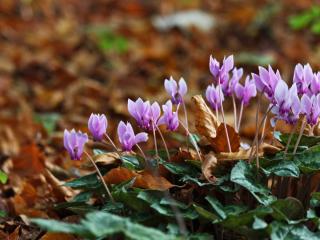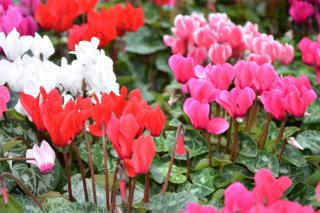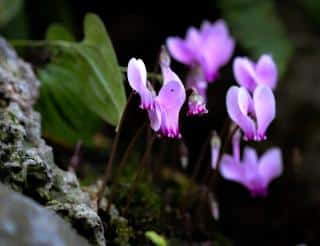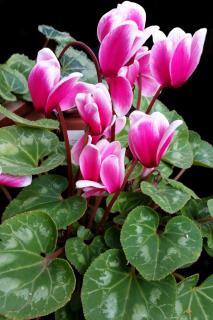

Cyclamen is one of the cutest houseplants to bloom indoors in fall and winter.
Core Cyclamen facts
Name – Cyclamen
Family – Primulaceae
Type – spring bulb
Height – 2 to 4 inches (5 to 10 cm)
Flowering – end of fall to early spring
Exposure – part sun – Soil – light and well drained
Care, planting and watering will help you make it bloom year after year.
Cyclamen, though often classified as a bulb flower, is actually a tuber. The roots look like flat, round patties.

Important! Make sure your tubers are right-side up! Topside should have a few eyes or buds, bottom side is where roots fan out.
It can be set in a pot, garden box and also in semi-shaded flower beds. In any case, only a very thin cover is needed for the bulb, with garden earth mixed with soil mix. Don’t bury it too deep: there should be no more than a half-inch (1.5 cm) of soil atop it.
For cyclamen purchased with flowers already, check that there are new buds forming, this will ensure the blooming will last longer.
Sowing is quite easy. Simply recover seeds when seed capsules open up and put them in nursery pots with soil mix.
Favor a luminous spot but not in the path of sunrays.
Avoid having nearby heat sources, such as radiators or a South-facing window.
The ideal temperature is around 65 to 70°F (16 to 18°C).
Cyclamen can’t stand heat. It appreciates cool evenings.
With these growing conditions, your cyclamen will bloom from September up to the month of May.

For that, remove the entire stem that bears the flower, rotating it just a bit in your hand and tugging it off with a sharp pull.
This twisting and tugging step is useful because if a portion of the wilted stem is left behind, it might rot and make the bulb rot.
Wait for soil to dry out thoroughly between 2 watering sessions, and avoid any excess water that might drown the plant.
Natural rainfall should be enough, except in case of strong heat or long-lasting dry spells.
At the beginning of spring, the plant will enter a dormant phase.
It will be possible to have it bloom again in the following fall, if you keep the bulb at rest during the summer.

Indoors, main issues are over and underwatering, and also too much sun exposure and dry air.
Remember, it’s a shade plant!

It’s fun little flowers seem to have their petals flipped upwards like Marylin Monroe’s skirt in the iconic “flying skirt” photo.
But Cyclamen is also connected to another “Mary” person in history: the virgin Mary.
There are hundreds of cyclamen plants. They differ in flower color, leaf shape, size, and blooming period. Outdoors, Cyclamen coum is great to resist deep cold freezing. Indoors, ivy-leaf cyclamen boasts intricate patterns on its leaves: nice to admire even when not blooming!
Certain Cyclamen varieties are used to produce fragrance that is added to perfume. It has a delicate, watery feeling that is similar to the refreshing effect a slice of cucumber has on a hot summer day.
Today, the scientific name, “Cyclamen”, comes directly from Latin. The “cycle” part of the name refers to the near perfect circle the flowers show when they’re lifted up. It actually comes from Ancient Greek, “κύκλος” or “kuklos”, which also means cycle. In many languages, the scientific name is used for the plant even in common language, which is rather rare!
Interestingly, in some areas of Greece, some recipes call for cyclamen leaves to be filled with delicious stuffing. But be careful! Cyclamen tubers are toxic!
Read also:
Amending the soil with special “flower plant” organic fertilizer will strongly increase growth and blooming of the plant.
I had no idea leaves were edible. Any recipes I can follow? Are leaves from all varieties edible?
Looking for plant roots such as corrigiola telephiifolia. I want roots similar in their chemical composition to these roots. Can you help? Look for the roots of soap wort.
Corrigiola is often produced in Morocco and Spain. I’m not sure it’s easy to find plants that have the same chemical composition. If you intend to use them medicinally, you should know it’s very difficult to predict how plant parts will interact with the body. It’s also impossible to predict what a plant can treat based on its chemicals, because even plants of the same species that are from different varieties may have different effects!
For Corrigiola, also called strapwort, here is an article that may help you a bit:
How to grow Strapwort or Corrigiola
Hello, why is this name called “Incense of Mary”? Is it because it has a beautiful organic fragrance? Is it possible to find cyclamen in bulk? Thanks
Hello Mustafa! It’s a very good question – and thanks to your asking, I looked up more interesting names for the Cyclamen flower. It’s now all written up in a new article you can read here:
Surprising links between Cyclamen and culture
About buying cyclamen in bulk, maybe simply go to your nearest garden store and look up what plant brands are there. If you get in touch with those, they might deliver to your area since they already have more regular customers nearby. Hope this helps!